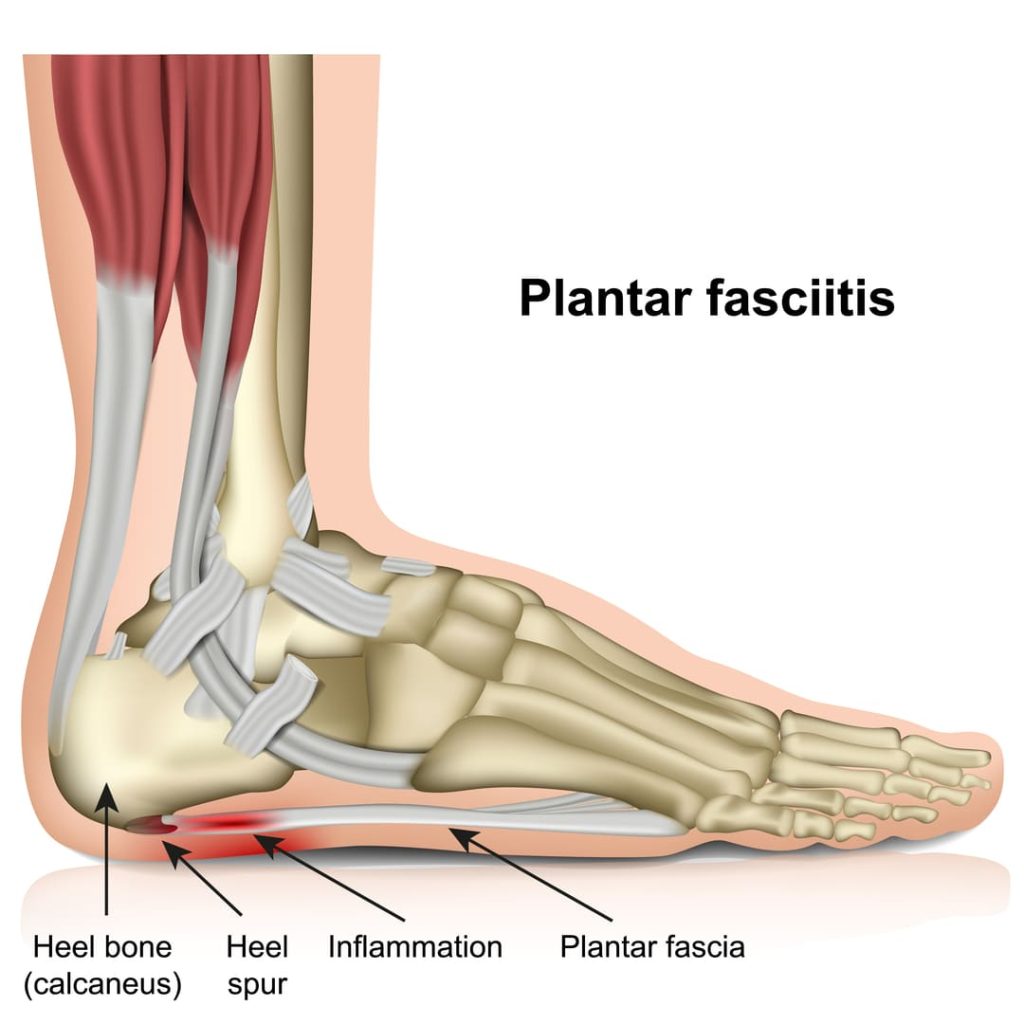Looking for Expert-Level VA Claim Answers?📱Call Us Now! 737-295-2226
The body is highly interconnected. What happens in the foot can affect the ankle. That can affect the knee, the hips, the back, and the neck.
That’s why at VA Claims Insider, we’re big proponents of secondary claims. We’ve seen many veterans leave the military with just one or two direct service-connected claims, but soon those disabilities metastasize into others, and you feel like you’re falling apart.
Because you weren’t experiencing these disabilities when you got out of the military, the VA didn’t know about them, and they aren’t compensating you for them. But that doesn’t change the fact that you wouldn’t be experiencing these secondary conditions if it weren’t for your military service.
Plantar fasciitis is one of these health problems that can cause–or result from–other service-connected disabilities.

You DESERVE a HIGHER VA rating.
Take advantage of a VA Claim Discovery Call with an experienced Team Member. Learn what you’ve been missing so you can FINALLY get the disability rating and compensation you’ve earned for your service.
What is plantar fasciitis?
If your heel hurts like heck when you get out of bed in the morning, you may have plantar fasciitis. Your heel bone is connected to your toes by a thick band of tissue known as the plantar fascia.
The plantar fascia serves as a vital buffer between your arch and the ground when you walk or run. But when it gets stressed and damaged, it can feel like someone is shoving a knife into your heel.
What causes it?
- Age. Like many parts of the body, the plantar fascia can wear down and/or become damaged with time.
- Stress. A lot of walking, standing, or running (think military PT) can wear out the plantar fascia.
- Inadequate support. Shoes with good arch support help prevent plantar fasciitis. Unfortunately, military combat boots are not known for their epic ergonomics.
- Obesity. If you’ve gained weight after leaving the military, this could increase pressure and stress on the plantar fascia.
While foot problems, including plantar fasciitis, are common in the general population as they age, research shows that they are significantly more common among military veterans.

What secondary conditions is plantar fasciitis linked to?
Let’s start by explaining what a secondary condition is. Perhaps you were experiencing plantar fasciitis when you got out of the military. Your primary care doctor referred you to a podiatrist who gave you an official diagnosis.
After you got out of the military, your plantar fasciitis continued and was not responsive to treatments. To minimize your foot pain, you started altering your gait as you walked. The unnatural movement of your foot puts extra strain on your ankles. Soon they began to hurt, too.
Plantar fasciitis can lead to:
- Heel spurs (as the plantar fascia tears, calcium builds up in those micro-tears, leading to bony protrusions on the bottom of the heel)
- Ankle pain
- Knee pain
- Hip pain
- Lower back pain
See a trend there? This is known as the “kinematic chain.” When you start shifting your weight around to avoid experiencing heel pain due to plantar fasciitis, the stress spreads to the ankle, knee, hips, and up your back. We’ve seen many cases where veterans have filed secondary claims for back conditions (such as degenerative disc disease) resulting from their plantar fasciitis and received compensation.
Another secondary condition related to plantar fasciitis is pes planus or flat feet. This occurs when the arch of your foot begins dropping so that it touches the ground (or comes close). You can be born with flat feet, or you can develop them with wear and tear.
A lot of the same factors that cause plantar fasciitis can cause flat feet (aging, obesity, stress, overuse). Foot and ankle injuries can also cause flat feet. Very often, flat feet cause plantar fasciitis because the arch of the foot is putting extra strain on the plantar fascia, stretching it away from the heel. If you’re rated for a direct service-connected disability of flat feet and you develop plantar fasciitis later, you may be eligible for compensation for plantar fasciitis as a secondary condition.

How does the VA rate plantar fasciitis?
The VA rates plantar fasciitis using diagnostic code 5269.
If both feet are affected, and the symptoms are not responsive to any kind of treatment, including surgery (or if the veteran is not a surgical candidate), it is rated 30%. If only one foot is affected, and the symptoms are not responsive to any kind of treatment, including surgery (or if the veteran is not a surgical candidate), it is rated 20%. If the symptoms are treatable, it is rated 10%.
If the condition is not responsive to treatment and is so severe that the foot cannot be used at all, it is rated 40% under code 5167 for loss of use of the foot.
How do I submit a secondary claim?
● Use the right form. You can submit your secondary VA claim using form Form 21-526EZ, but this must be done in conjunction with getting the proper medical and personal documentation to build your case. You can also file your claim online through your va.gov account. Through this, a 21-526EZ form will not be necessary.
● Get a diagnosis. Start by talking to your doctor about the health problems you are experiencing that may be connected to your plantar fasciitis. You will need to secure a diagnosis for this secondary problem. It can come from a VA doctor or any civilian medical professional (including a physician assistant or nurse practitioner). If they will not grant you a diagnosis, don’t be shy about seeking a second opinion from another medical provider.
● Get an Independent Medical Opinion (IMO) or a medical nexus letter. In addition to providing a diagnosis, your doctor must provide documentation tying your secondary diagnosis to an existing service-connected condition (known as a nexus statement or nexus letter). They may use wording like, “It is at least as likely as not that (patient’s) degenerative disc disease results from the altered gait caused by their plantar fasciitis.” Make sure to get a copy of all of the medical documentation to provide to the VA.
Once you submit, you may be asked to undergo a Compensation and Pension Exam (C&P) through the VA after submitting your claim. Don’t be nervous or alarmed. This is a normal part of the process and can help you build your case for your secondary claim.

What else can help my secondary claim?
The one challenge with the C&P exam is that it only provides the doctor with a single snapshot of your condition. If your condition doesn’t happen to be flaring on that day, or if your condition can not be readily observed by the doctor, you can strengthen your case by providing them with the following documents. You can also submit these documents directly to the VA online when you file your claim.
● Personal statement. This statement can be completed using form VA 21-4138. It comes directly from you and details your direct service-connected condition as well as the evolution of your secondary condition.
You can talk about your symptoms, the date they first developed, their duration, their frequency, their severity, etc. Describe how they impact your work life (if applicable) and personal life.
●Buddy letters. These are statements from people who have information about your secondary condition. The “buddy” could be a spouse, friend, fellow service member, or co-worker. Their statement must be issued and signed on a VA 21-10210.
The buddy should provide their full name and contact information (address and phone number) and describe their relationship to you. Buddy statements are often a few paragraphs long and detail how your secondary condition manifests in everyday life.
For example, a past employer could talk about how your back condition resulting from your plantar fasciitis caused you to miss work repeatedly or how they observed you walking with an altered gait due to your plantar fasciitis.
Most medical problems don’t exist in a vacuum. It’s very probable that your direct service-connected injuries are affecting other aspects of your life that may not have been apparent when you left the military.
If your plantar fasciitis is leading to other health problems–or if another service-connected diagnosis is leading to plantar fasciitis–we can provide you with the support and resources you need to file a secondary VA claim and get the compensation you’re legally entitled to.

NEED MORE ASSISTANCE?
Most veterans are underrated for their disabilities and, therefore, not getting their due compensation. At VA Claims Insider, we help you understand and take control of the claims process, so you can get the rating and compensation you’re owed by law.
Our process takes the guesswork out of filing a VA disability claim and supports you every step of the way in building a fully-developed claim (FDC)—so you can increase your rating FAST! If you’ve filed your VA disability claim and have been denied or have received a low rating—or you’re unsure how to get started—reach out to us! Take advantage of a FREE VA Claim Discovery Call. Learn what you’ve been missing—so you can FINALLY get the disability rating and compensation YOU DESERVE!


